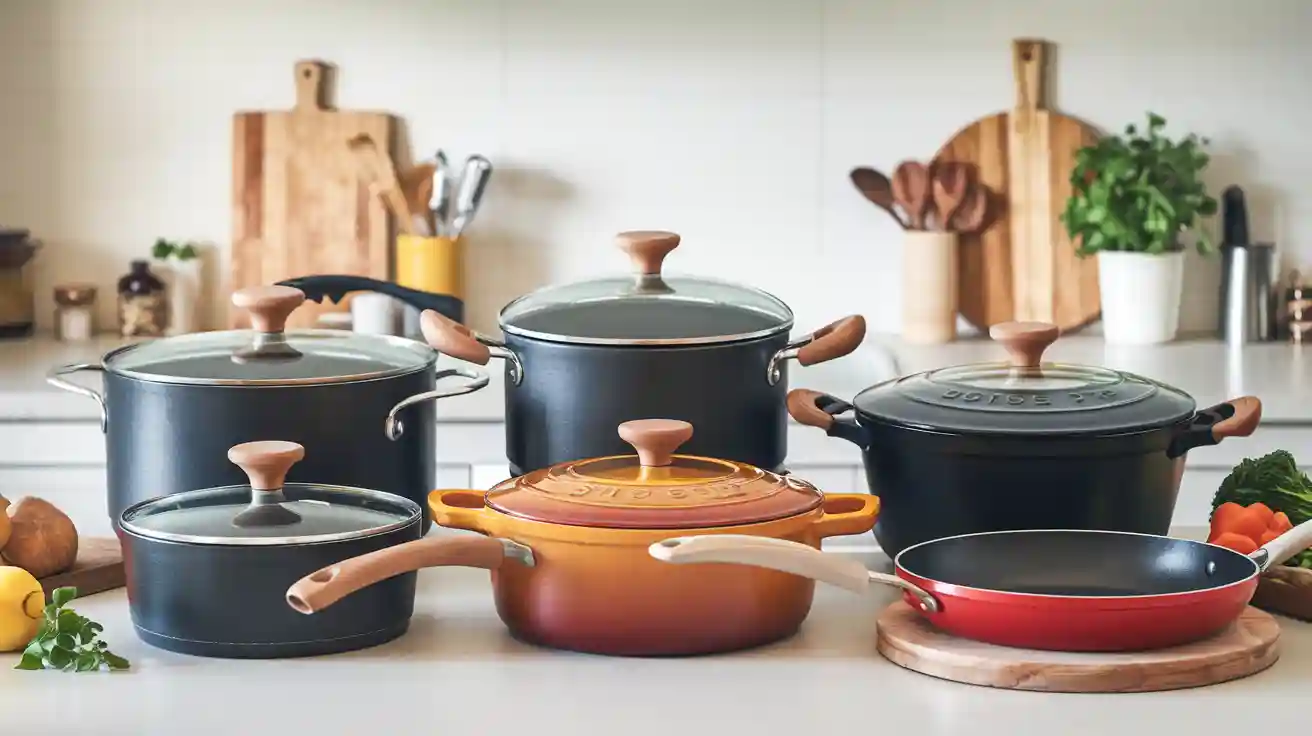
When you build your cookware sets, you need the right types of pots and pans for every kitchen. These essential pieces—saucepan, frying pan, sauté pan, Dutch oven, and stockpot—form the core of cookware sets pots. With these kitchen essentials, you can handle frying, boiling, simmering, and more. Each pot brings unique features to your everyday essentials, making them must-have gear for any home kitchen.
The five essential pots and pans let you master at least 12 different cooking techniques, such as frying, simmering, and braising.
| Cookware Pot | Cooking Techniques |
|---|---|
| Saucepan | Simmering, cooking grains, boiling vegetables |
| Sauté Pan | Browning meat, sautéing vegetables, one-pan dishes |
| Frying Pan | Frying, searing, browning |
| Dutch Oven | Braising, baking, slow cooking |
| Stockpot | Making soups, making stocks, boiling pasta |
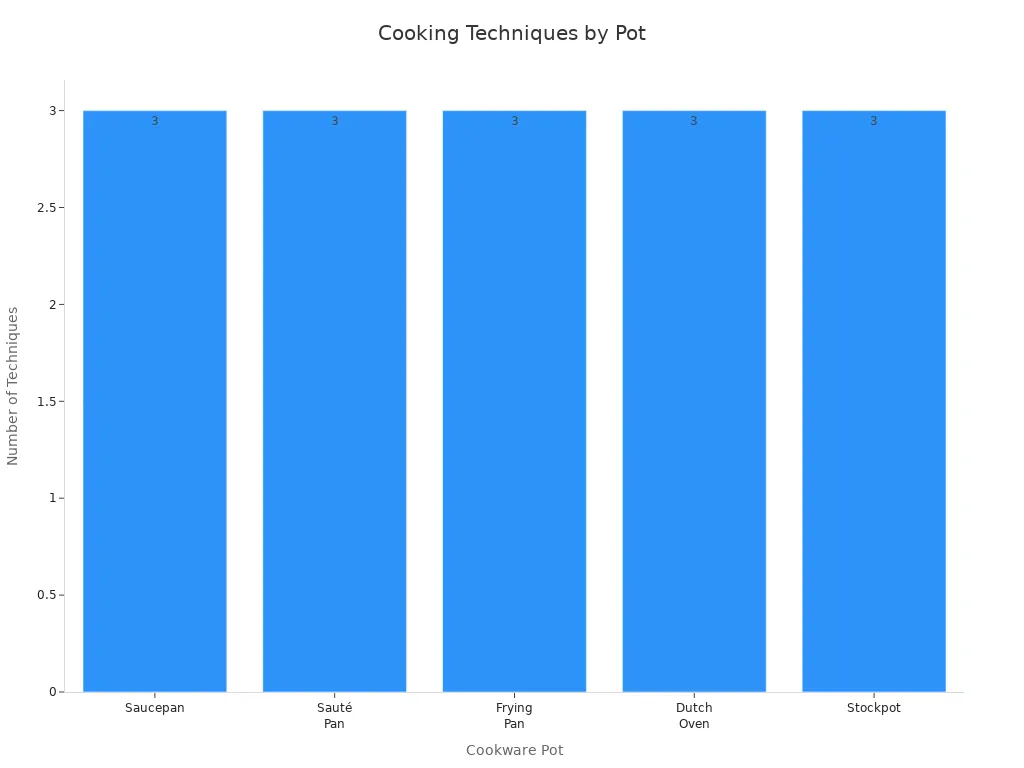
Saucepan: An Essential Item in Cookware Sets
Primary Uses
You will find the saucepan in every well-equipped cooking set. This pot works best for making sauces, heating liquids, and cooking grains. Its tall, straight sides and long handle help you control heat and moisture. You can use a saucepan to simmer soups, boil eggs, or prepare oatmeal. The design also makes it easy to reduce sauces and thicken custards. Many home cooks use a saucepan for blanching vegetables or poaching eggs. You get better control over small to medium batches, which is not possible with larger pots.
Tip: The tight-fitting lid on a saucepan helps lock in moisture and flavor, making it perfect for delicate recipes.
Recommended Sizes
Choosing the right size for your saucepan depends on your cooking set and family size. Most people prefer to own two sizes for flexibility. If you want to cover most recipes, a 2-quart and a 4-quart saucepan will serve you well. The 3-quart and 4-quart sizes are the most popular choices for many brands. These sizes let you cook for one person or a small group without overcrowding.
| Size Range (Quarts) | Typical Serving Capacity | Common Uses and Popularity |
|---|---|---|
| 1 to 1.5 | Serves 1 person | Great for single-serve meals; less popular |
| 2 to 2.5 | Serves 1-2 people | Ideal for sauces, soups, small batches; frequently purchased |
| 3 to 3.5 | Serves 2-3 people | Good for grains, oatmeal, chili; moderately popular |
| 4 | Serves 3-4 people | Best seller for some brands; great for stews, pasta, stocks |
Why It’s Essential
A saucepan is essential for every cooking set because it fills a unique role. You can use it for tasks that other pots cannot handle as well. The tall sides and narrow base help you heat liquids evenly and prevent boil-overs. You get precise temperature control, which is important for sauces and custards. The saucepan bridges the gap between a pan and a pot, making it a must-have in any stainless steel cookware set. When you build your stainless steel cookware set, always include a saucepan to cover a wide range of recipes and techniques.
Frying Pan or Skillet: Core Cookware Set Piece
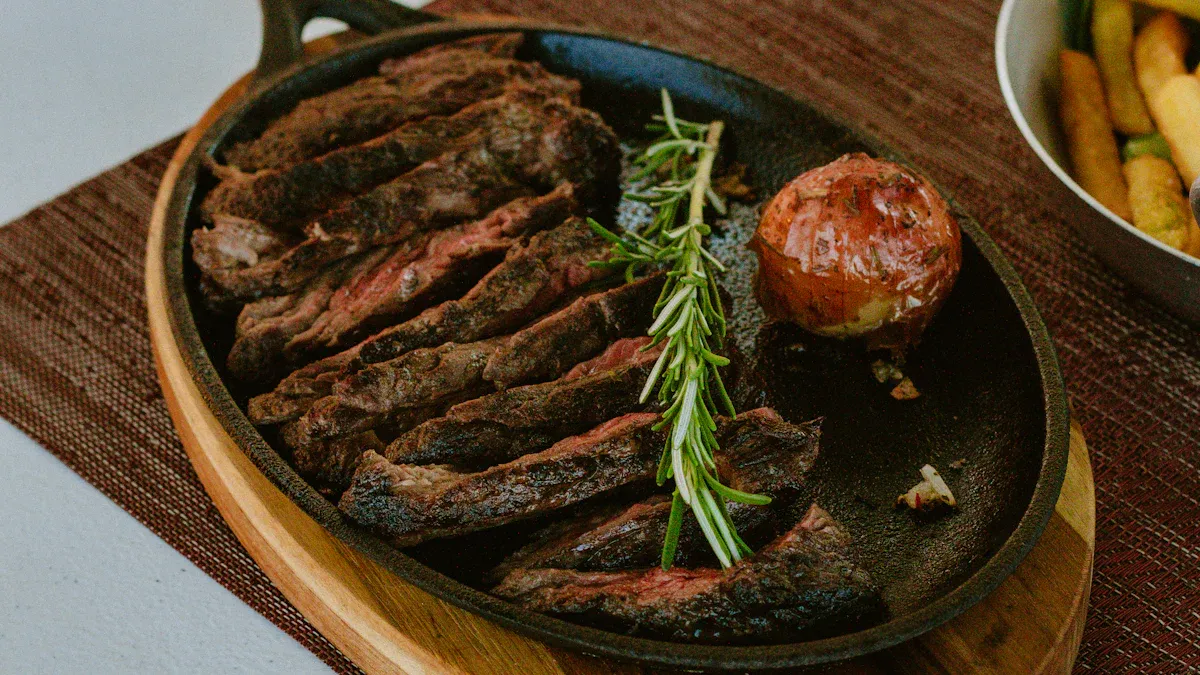
Primary Uses
You will reach for a frying pan almost every day. This pan handles many tasks in your cooking set. You can use it for frying eggs, searing steaks, or browning meats and vegetables. The frying pan also works well for making pancakes, crisping bacon, and frying chicken. You can sauté vegetables, stir-fry, or even simmer one-pot meals. Many cooks use a frying pan to make cornbread or frittatas because it moves easily from stovetop to oven. The even heat of a frying pan helps you lock in juices and create a perfect crust on meats.
- Searing steaks
- Frying eggs or pancakes
- Browning meats and vegetables
- Sautéing vegetables
- Stir-frying
- Simmering one-pot meals
- Making cornbread and frittatas
Tip: A non-stick skillet makes frying delicate foods like eggs and pancakes much easier and helps with cleanup.
Recommended Sizes
You should include at least two frying pans in your cooking set. The most popular sizes are 8-inch and 12-inch. The 8-inch frying pan is great for single servings or small meals. The 12-inch frying pan gives you enough space for family-sized dishes or when you want to fry several pieces at once. Some cooks also like a 10-inch pan for its balance between size and control. Choose pans that fit your stove and your usual recipes.
| Size (Inches) | Best For |
|---|---|
| 8 | Eggs, pancakes, small portions |
| 10 | Sautéing, stir-frying, 2-3 people |
| 12 | Family meals, frying chicken, large cuts |
Why It’s Essential
A frying pan is essential in every cooking set because it offers unmatched versatility. The flat base and flared sides let you toss food and cook evenly. You can use frying pans on many surfaces, including induction burners, ovens, and even campfires. Materials like carbon steel, cast iron, and stainless steel handle high heat for frying and searing. Lighter pans with good handles make flipping food easy. With proper care, some frying pans last a lifetime. When you build your cooking set, always include a frying pan for everyday frying, sautéing, and more.
Sauté Pan: Versatile Essential Piece
Primary Uses
You will find the sauté pan stands out in your cooking set because of its straight, high sides and wide base. This design lets you cook dishes that need more liquid, like stews, curries, and braised meats. The sauté pan holds sauces and broths without spilling, making it perfect for simmering and braising. You can use it for leafy greens, beans, or any recipe that needs moisture retention. Unlike frying pans, which work best for quick, dry-heat cooking, the sauté pan helps you manage larger volumes and keeps food from splattering. Many sauté pans come with lids, so you can trap heat and moisture for even cooking.
Tip: Choose a sauté pan when you want to make saucy dishes or one-pan meals that need both searing and simmering.
Recommended Sizes
For most home cooks, a sauté pan with a 3-quart capacity fits well in your cooking set. This size lets you cook enough food for a family meal, such as six chicken thighs or a batch of stew. If you often cook for a crowd, you might want a larger sauté pan, up to 6 quarts. Professional kitchens use even bigger pans, but for home use, 3 to 6 quarts covers most recipes. Pick a size that matches your stove and the number of people you serve.
Why It’s Essential
A sauté pan is an essential part of your cooking set because it offers versatility that other pans cannot match. The wide base and high sides let you sauté, pan-fry, simmer, and braise all in one pot. Many sauté pans have features like nonstick surfaces, hard-anodized aluminum cores, and tempered glass lids. These features help you cook evenly, clean up easily, and use the pan on any cooktop, including induction. You can even finish dishes in the oven. The sauté pan’s depth also reduces splatters and holds more food, making it a smart choice for busy kitchens. When you want a pan that does more than just fry, add a sauté pan to your cooking set.
| Feature | Benefit |
|---|---|
| High, straight sides | Holds liquids and prevents spills |
| Wide cooking surface | Great for browning and one-pan meals |
| Lid included | Traps moisture for braising and simmering |
| Oven and induction safe | Works with many cooking methods |
Dutch Oven: Must-Have for Every Cookware Set
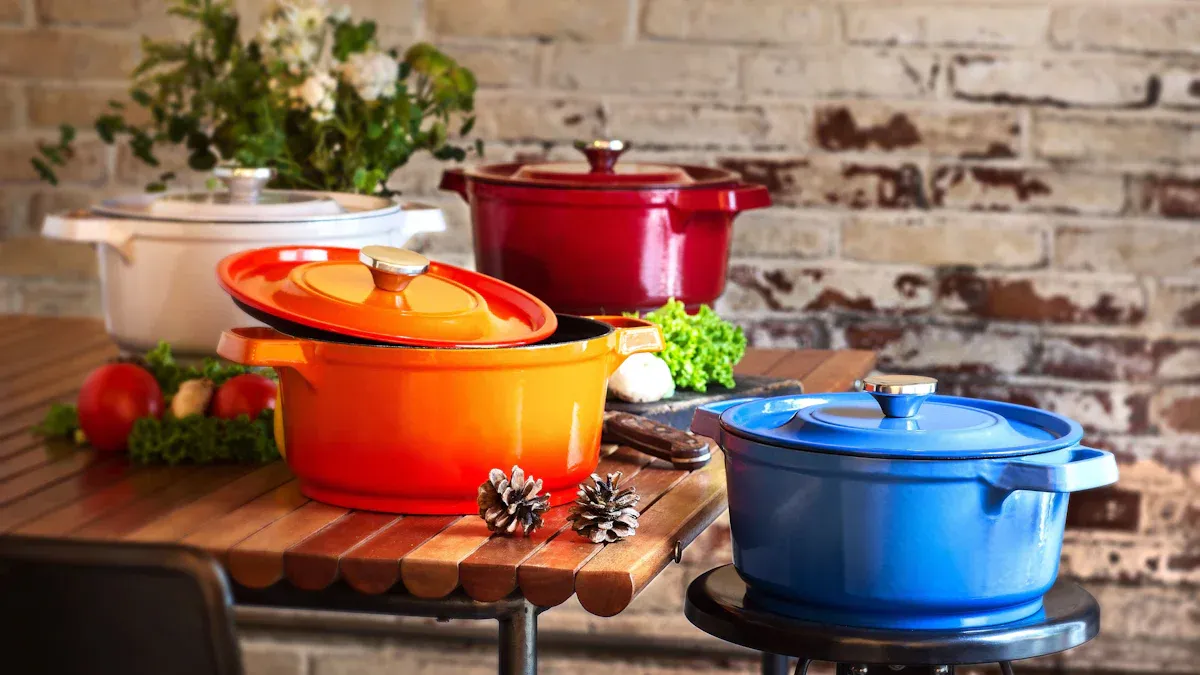
Primary Uses
You will find a Dutch oven to be one of the most versatile pieces in your cooking set. This pot handles many tasks that other cookware cannot match. You can use it for:
- Braising meats for tender, flavorful results
- Simmering hearty dishes like chili and stews
- Roasting vegetables or meats
- Baking bread right on your stovetop or in the oven
- Preparing soups, one-pot meals, and even desserts
- Slow cooking brisket, chicken, or large cuts of meat
A Dutch oven excels at slow cooking and braising. You can create rich, comforting meals with very little effort.
Recommended Sizes
When you choose a Dutch oven for your cooking set, size matters. Most home cooks find a medium Dutch oven, around 5.5 quarts, to be the most useful. This size serves four to six people and works for braising, deep-frying, and sautéing. Here are the common options:
- Small (1 to 3.5 quarts): Best for individuals or couples
- Medium (5 to 7 quarts): Most versatile, fits most recipes and families
- Large (8 to 10+ quarts): Ideal for big batches, holiday meals, or large families
Round Dutch ovens fit most stovetops and recipes. Oval shapes work well for large proteins like whole chickens or roasts.
Why It’s Essential
A Dutch oven stands out in any cooking set because of its unique features. Most Dutch ovens use cast-iron cookware construction, which holds and spreads heat evenly. This makes them perfect for braising and baking bread. Many Dutch ovens have enamel coatings that make cleaning easy and allow you to see your food as it cooks. Some models can handle oven temperatures up to 500°F, which is important for bread baking and roasting.
| Feature/Aspect | Explanation |
|---|---|
| Enamel Coating | Easy to clean and lets you monitor food while braising |
| Heat Resistance | Withstands high oven temperatures, great for baking bread |
| Cast Iron Material | Retains and distributes heat for even cooking |
| Versatility | Handles stews, braises, baking, roasting, and more |
You can use a Dutch oven for almost any recipe that needs slow, even heat. This makes it a must-have for anyone building a complete cooking set or looking to expand their cast-iron cookware collection.
Stockpot: Indispensable Cookware Sets Pot
Primary Uses
You will find the stockpot to be one of the most important pieces in your cooking set. This pot handles big jobs that smaller pots cannot manage. In both home and commercial kitchens, you use a stockpot for:
- Making soups, stews, and broths in large amounts.
- Preparing stock, which forms the base for many recipes.
- Boiling pasta, seafood, or vegetables in bulk.
- Simmering and reducing sauces or gravies.
- Cooking large batches for family meals or events.
Tip: A stockpot’s tall sides help prevent spills when you simmer large volumes of liquid.
Recommended Sizes
Choosing the right size stockpot for your cooking set depends on your family size and cooking habits. The 8-quart stockpot is the most common choice for families of one to four people. It gives you enough space for soups, pasta, or homemade stock without being too heavy to handle. If you cook for a crowd or want to freeze leftovers, you might pick a 10- or 12-quart pot. For most home kitchens, experts recommend 6- and 8-quart sizes as the best balance between capacity and ease of use.
| Stockpot Size (quarts) | Typical Servings | Recommended Use / Family Size |
|---|---|---|
| 6 | About 12 | Small families, soups, pasta |
| 8 | About 16 | Most families, stocks, stews |
| 10-12 | 20-24 | Large families, big batches |
| 16+ | 32+ | Commercial kitchens |
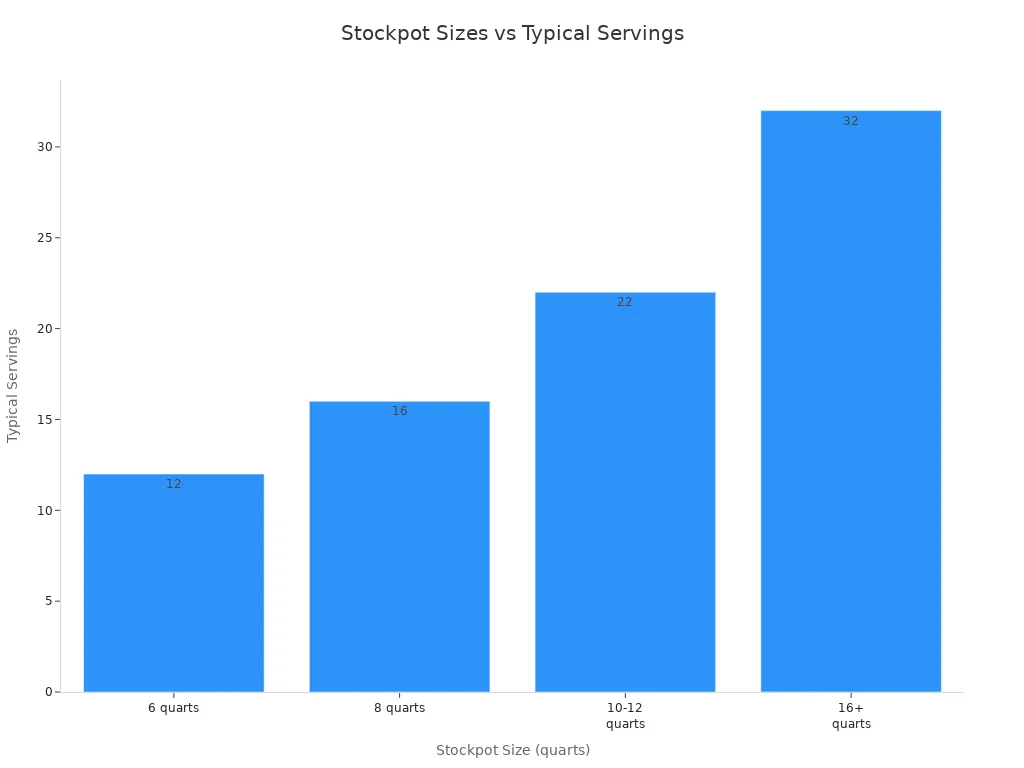
Why It’s Essential
You need a stockpot in your cooking set because it lets you cook large quantities efficiently. The generous size and sturdy build help you handle big batches of stew, chili, or pasta. You can use it for boiling, simmering, poaching, blanching, or even deep-frying. A good stockpot distributes heat evenly, so your food cooks the same all the way through. When you make stock or soup, you avoid boil-overs and spills. The stockpot’s versatility means you can prepare meals for a group or freeze portions for later. Every complete cooking set should include a stockpot for these reasons.
How to Choose the Right Cookware Sets Pots
Material Considerations
When you build your ideal cooking set, you need to think about the materials of your pots. Each material affects how your cookware sets pots perform in the kitchen. Some pots heat up quickly, while others hold heat longer. You want to choose the right stainless steel cookware set or other materials based on your cooking needs. The table below shows how different materials compare:
| Material | Heat Conductivity | Reactivity | Durability & Care | Weight | Compatibility |
|---|---|---|---|---|---|
| Copper | Excellent | Reactive | Needs polishing | Heavy | Not induction compatible |
| Aluminum | Very good | Reactive | Easy to clean if coated | Light | Not always induction ready |
| Carbon Steel | Good | Reactive | Needs seasoning | Moderate | Works on all cooktops |
| Stainless Steel | Moderate | Nonreactive | Low maintenance | Moderate | Induction compatible |
| Cast Iron | Slow to heat | Nonreactive | Needs seasoning or enamel | Heavy | Oven safe, all cooktops |
| Stoneware | Even heating | Nonreactive | Fragile | Moderate | Oven use mainly |
You get the best cookware when you match high-quality materials to your cooking style. Stainless steel cookware set pots are popular because they last long and work on most stoves.
Size and Capacity
You need to pick pots that fit your cooking set and your family size. The size and capacity of your cookware sets pots affect how much food you can make and how well your food cooks. A large pot lets you cook for a group, while a small pot works for single servings. The diameter controls the cooking surface, so a wider pot gives you more space and better heat. Depth matters too. Shallow pans are great for frying, but deep pots are better for soups and stews. Always match the pot size to your burner for even cooking. If you want an ideal cooking set, choose pots in different sizes for all your recipes.
Tip: For a family of four, an 8-quart stockpot and a 3-quart saucepan cover most needs in a cooking set.
Matching Pots to Cooking Style
You want your cookware sets pots to match how you cook every day. Think about what you make most often. If you love searing steaks, a cast iron pot works best. For soups and sauces, a stainless steel cookware set gives you nonreactive, even heating. Make sure your pots fit your stove, whether it is gas, electric, or induction. Look for oven-safe handles and tight lids for more cooking options. Choose the right stainless steel cookware set if you want durability and easy cleaning. Always balance quality, size, and price. The best cookware fits your habits and helps you enjoy cooking. When you focus on matching pots and pans to your style, you build a high-quality pot collection that lasts.
Optional and Specialty Pots for Expanding Your Cookware Set
When you want to go beyond the basics, you can add specialty types of pots to your kitchen. These pieces help you cook new recipes and make your 10-piece set even more useful.
Steamer Pot
A steamer pot gives you a healthy way to prepare food. You can steam vegetables, fish, and even buns. This method keeps more nutrients in your meals and cuts down on added fats or oils. You will also notice that steaming cooks food faster because it uses less liquid. Most steamer pots use stainless steel, which lasts a long time and cleans up easily. You can use this pot for more than just vegetables. Try it for scalding milk, poaching fruit, or making desserts.
- Healthier meals with less fat
- Faster cooking times
- Durable stainless steel construction
- Easy to clean
- Versatile uses beyond vegetables
Pasta Pot
A pasta pot is one of the most helpful types of pots for anyone who loves Italian food. Most pasta pots hold six to eight quarts, which is perfect for home kitchens. Unlike stock pots, pasta pots often come with a strainer insert. This feature lets you drain noodles quickly and safely. Stock pots do not include this insert, so pasta pots make cooking and draining pasta much easier. You can also use a pasta pot for boiling potatoes or making soup in your 10-piece set.
Wok
A wok stands out among types of pots because of its unique shape. You can use a wok for stir-frying, deep-frying, or steaming. The sloped sides help you toss food and cook it evenly. Many people use a wok for Asian dishes, but you can also use it for scrambled eggs or sautéed vegetables. A wok heats up fast and works well with many types of cookware.
Saucier
A saucier is a special pan that helps you make smooth sauces and custards. The rounded corners and sloped sides make stirring and whisking easy. Food does not get stuck in the corners, so cleanup is simple. You can use a saucier for tasks like making hot cocoa or whisking cream. The rolled rim helps you pour without drips. This pan is different from regular saucepans, which have straight sides and sharp corners. If you want to try new recipes, a saucier is a smart addition to your cookware collection.
You need five essential pots: saucepan, frying pan, sauté pan, Dutch oven, and stockpot. Choose quality materials and the right sizes for your cooking style.
- Look for sturdy handles and tight lids.
- Pick pots that fit your family and kitchen space.
- Build your set over time for lasting value.
The right cookware improves your cooking results and keeps food tasty and nutritious. Durable pots like stainless steel or cast iron help you cook safely and enjoy every meal.
FAQ
What is the difference between a sauté pan and a frying pan?
A sauté pan has straight sides and a larger surface. You use it for simmering and braising. A frying pan has sloped sides for quick frying and flipping.
How do you clean burnt food from stainless steel pots?
Fill the pot with water and a little baking soda. Boil for a few minutes. Use a non-abrasive sponge to scrub away the residue.
Can you use a Dutch oven on any stovetop?
Yes, you can use a Dutch oven on gas, electric, and induction stovetops. Always check the manufacturer’s instructions for your specific model.


